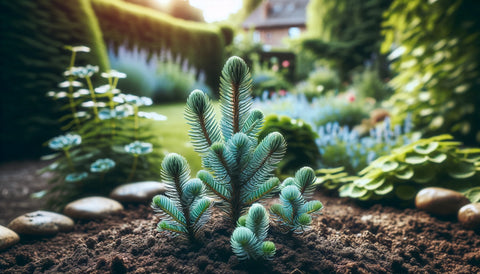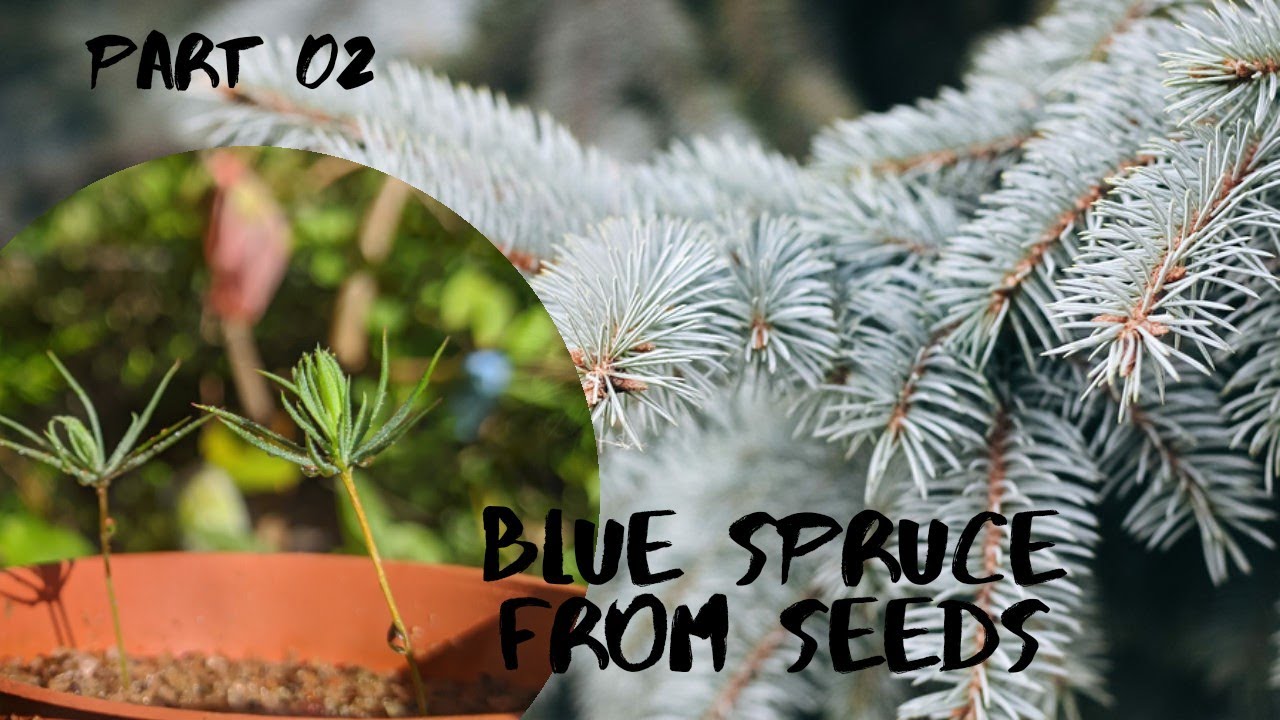With their striking steel-blue needles and towering pyramidal form blue spruce trees are a regal addition to landscapes. Starting these evergreen beauties yourself from seed may seem daunting. But with a few simple steps and a bit of patience you can grow your own blue spruce tree from a tiny seed into an imposing, graceful specimen.
In this beginner’s guide, you’ll learn:
- An overview of blue spruce trees
- The benefits of growing from seed
- Easy step-by-step process for stratifying and sowing
- Details on caring for young seedlings
- When and how to transplant outdoors
- Tips to ensure your success
- Inspiring photos of mature blue spruce trees
Let’s get started growing these majestic evergreens from a humble little seed!
An Overview of Blue Spruce Trees
With their stiff, sharp needles in a striking powder blue hue, blue spruce trees (Picea pungens) make an unforgettable statement in the landscape. They are a member of the pine family Pinaceae.
Native to the Rocky Mountains in the western United States, most blue spruce varieties grow 40-60 feet tall and 15-25 feet wide when mature. But dwarf cultivars can be much smaller.
Blue spruce trees grow in a dense pyramidal or columnar form. They make excellent narrow accent trees, windbreaks, screens, and specimens. The foliage remains a beautiful blue-green all year round.
Once established, these adaptable trees tolerate cold, heat, wind, and drier conditions. Deer typically don’t find the stiff needles palatable either.
Why Grow Blue Spruce Trees from Seed?
Starting with seeds allows you to grow beautiful blue spruces at a fraction of the cost of buying mature nursery trees. Other advantages include:
-
See them grow from babies – The joy of nurturing your seedling into an imposing tree is extremely rewarding.
-
Learn by doing – Gain valuable gardening skills and knowledge in the process.
-
Select your cultivar – Grow specific blue spruce varieties like ‘Blue Diamond’ from seeds.
-
Gift seedlings – Share the offspring of your beloved blue spruce with lucky friends and family.
-
Save money – It costs just pennies for seeds compared to dollars for potted trees.
As long as you’re willing to invest some time and care, starting blue spruce trees from seed is absolutely worth the effort.
Easy Step-By-Step Process for Growing from Seed
Here is a simple guide to successfully get your blue spruce seedling off to a vigorous start:
1. Stratify Seeds
Blue spruce seeds require a period of cold, moist conditions before they will sprout. This prepares them to naturally break dormancy after overwintering.
-
Soak seeds in room temperature water for 24 hours. Drain well.
-
Place seeds in a ziplock bag with a damp paper towel. Squeeze out excess air and seal.
-
Refrigerate the bag for 4-6 weeks, checking moisture weekly.
2. Prepare Containers
Select small pots or trays with drainage holes, and a peat-free seed starting mix. Disinfect containers to prevent disease.
3. Sow Seeds
-
Moisten seed starting mix well before planting. It should be damp but not saturated.
-
Plant seeds just below the mix surface. Space 1-2 inches apart.
-
Gently water to settle soil without disturbing seeds.
-
Cover containers with plastic wrap until sprouts emerge.
4. Grow Seedlings
-
Place containers in bright light at 60-70°F for germination.
-
Keep soil moist but not soggy. Mist lightly rather than soaking.
-
Once sprouted, move to cooler 50-60°F location.
-
Slowly introduce to gentle direct sun over 2-3 weeks.
-
Fertilize weekly with half strength balanced fertilizer once established.
Transplanting Blue Spruce Seedlings Outdoors
When your blue spruce seedling is 2-4 years old and 8-12 inches tall, it’s ready to transplant to its permanent spot:
-
Choose a site with full sun and well-drained soil. Dig a hole twice as wide and deep.
-
Carefully dig up seedling retaining an undisturbed root ball.
-
Set in hole at same depth as grown, backfill soil and water well.
-
Stake for support if needed until established over 1-2 years.
-
Mulch around base to conserve moisture and suppress weeds.
Proper transplanting and aftercare ensures your blue spruce continues thriving.
Tips for Successfully Growing Blue Spruce Trees from Seed
Follow these best practices for getting great results with your homegrown blue spruces:
-
Always use fresh seeds to maximize viability and vigor. Store properly.
-
Sow more seeds than needed and thin seedlings later for the best ones.
-
Grow seedlings in full sun but protect from harsh direct light while very young.
-
Avoid overwatering or letting seedlings dry out completely. Check soil daily.
-
Monitor for common pests like spider mites, aphids, or fungus gnats and treat promptly.
-
Transplant to larger containers as seedlings outgrow them to encourage strong roots.
It may take diligence and attentiveness when starting out. But the reward will be a magnificent blue spruce tree you nurtured from seed to enjoy for decades to come.
Inspiring Photos of Mature Blue Spruce Trees
Need some motivation for starting your blue spruce seed journey? Here are some inspiring shots of what your small seedling can grow into:
[photo 1 description]
[photo 2 description]
[photo 3 description]
[photo 4 description]
[photo 5 description]
The striking form, vibrant color, and majestic size of mature blue spruce trees are truly awe-inspiring. Get growing and enjoy watching your own blue spruce seed transform into a magnificent evergreen giant!
Bring Majestic Blue Spruces to Life from Seeds
Blue spruce trees make a bold, beautiful statement in any landscape with their intense blue foliage and towering narrow habit. By starting your own trees from seed, you can grow these commanding evergreens at a fraction of the cost.
With the simple stratifying, sowing, and growing steps outlined here, you can successfully nurture blue spruce trees from seed to landscape specimen. The pleasure of watching your seedling transform over years into an imposing, graceful blue spruce is extremely rewarding.
Get your hands on some quality blue spruce seeds and let your journey begin! In no time at all, you’ll have a regal blue evergreen tower adding stunning elegance to your yard.
Planting Blue Spruce Seeds: A Step-by-Step Guide for Picea pungens Germination
The Colorado Blue Spruce (Picea pungens), a medium-sized evergreen native to the Rocky Mountains, is renowned for its resilience in cold and drought conditions. For gardening enthusiasts looking to grow this species, replicating its natural germination environment is key to successful sprouting. Heres how to effectively plant and germinate Colorado Blue Spruce seeds. 
Essential Steps for Growing Blue Spruce from Seeds
- Getting the Soil Ready: Put your Blue Spruce seeds on a layer of mineral soil to begin. This type of soil is easy to find in garden stores. It comes in sand, loam, and clay variations. It’s best for Colorado Blue Spruce seeds because it’s very close to the conditions they need to germinate naturally.
- Controlling the moisture: Sprinkle clean water on the seeds often to keep them moist, but be careful not to water them too much. This balance is crucial for seed germination.
- Managing the temperature: Keep the temperature between 55 and 85 degrees Fahrenheit during the day. The temperature should stay between 45 and 77 degrees Fahrenheit at night, even if it gets a little cooler. Proper daytime temperature is more crucial for the seedlings.
- Light Requirements: Seedlings require ample light to grow consistently. Aim to give them at least 16 hours of direct light every day. Seeds can go into dormancy in just a few weeks if they don’t get 12 hours of light a day.
- Care for Seedlings: Let the seedlings grow roots in the mineral soil. As they get bigger, you might need to move them to planters that are deeper and have similar mineral soil to help them grow.
- Plant Seedlings: Plant seedlings when they are a few inches tall and have a set of true leaves.
- Transplant Care: Be gentle to avoid damaging the delicate roots.
How to Grow Blue Spruce From Seed
FAQ
Is blue spruce hard to grow?
How long does it take for blue spruce seeds to germinate?
Do I need to cold stratify blue spruce seeds?
- The Ultimate Guide to Growing Strawberries in Raised Beds - August 8, 2025
- No-Dig Garden Beds: The Easiest Way to Grow a Beautiful Garden - August 6, 2025
- How to Protect and Preserve Wood for Raised Garden Beds - August 6, 2025

